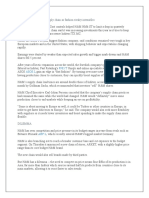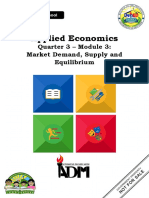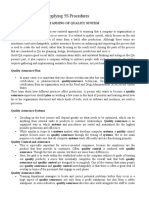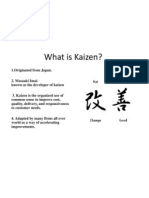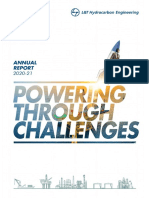0 ratings0% found this document useful (0 votes)
39 views5'S
5'S
Uploaded by
Sharny Lee BasarteThis document discusses the 5S method, which aims to organize workspaces for efficiency through sorting, setting in order, shining, standardizing, and sustaining. The 5S method promotes foolproof systems, standard policies, and a healthy work culture. Implementing 5S can provide benefits like improved profitability, a more efficient workforce, a safer workplace, and better customer perception. Each of the five steps is described in detail, and the importance of sustaining the changes through management commitment and employee engagement is emphasized.
Copyright:
© All Rights Reserved
Available Formats
Download as PPTX, PDF, TXT or read online from Scribd
5'S
5'S
Uploaded by
Sharny Lee Basarte0 ratings0% found this document useful (0 votes)
39 views13 pagesThis document discusses the 5S method, which aims to organize workspaces for efficiency through sorting, setting in order, shining, standardizing, and sustaining. The 5S method promotes foolproof systems, standard policies, and a healthy work culture. Implementing 5S can provide benefits like improved profitability, a more efficient workforce, a safer workplace, and better customer perception. Each of the five steps is described in detail, and the importance of sustaining the changes through management commitment and employee engagement is emphasized.
Original Description:
5S
Original Title
2. 5'S
Copyright
© © All Rights Reserved
Available Formats
PPTX, PDF, TXT or read online from Scribd
Share this document
Did you find this document useful?
Is this content inappropriate?
This document discusses the 5S method, which aims to organize workspaces for efficiency through sorting, setting in order, shining, standardizing, and sustaining. The 5S method promotes foolproof systems, standard policies, and a healthy work culture. Implementing 5S can provide benefits like improved profitability, a more efficient workforce, a safer workplace, and better customer perception. Each of the five steps is described in detail, and the importance of sustaining the changes through management commitment and employee engagement is emphasized.
Copyright:
© All Rights Reserved
Available Formats
Download as PPTX, PDF, TXT or read online from Scribd
Download as pptx, pdf, or txt
0 ratings0% found this document useful (0 votes)
39 views13 pages5'S
5'S
Uploaded by
Sharny Lee BasarteThis document discusses the 5S method, which aims to organize workspaces for efficiency through sorting, setting in order, shining, standardizing, and sustaining. The 5S method promotes foolproof systems, standard policies, and a healthy work culture. Implementing 5S can provide benefits like improved profitability, a more efficient workforce, a safer workplace, and better customer perception. Each of the five steps is described in detail, and the importance of sustaining the changes through management commitment and employee engagement is emphasized.
Copyright:
© All Rights Reserved
Available Formats
Download as PPTX, PDF, TXT or read online from Scribd
Download as pptx, pdf, or txt
You are on page 1of 13
THE 5S.
This is a method used in good housekeeping that aims to organize
offices, rooms, warehouse and other workstation to achieve efficiency in the
company workflow. Simple to talk about but in reality this is one of the hardest
method in TQM since it requires a habit of letting go of unnecessary things and
keeping what is important. For us Filipinos, this is hard since we usually practice
to keep things as memoirs. 5S promotes:
• Foolproof systems
• Standard policies, rules and regulations
• Healthy work culture at the organization
• Reduces waste and non-value activity
• Worker’s morale increase
• Customer perception on company products improve
• Organizational efficiency increased
• Lesser waste and better quality
• Faster lead times
Benefits of implementing 5S.
• Improved profitability
• More efficient workforce
• Better service
• Safer workplace
SEIREI (SORT). This means the identification of items that is still
valuable to the company. Only necessary ones are kept for
continued use which means that unnecessary ones should be
disposed or kept in storage out in the office. This process lead to
fewer hazards and less clutter that might interfere with productive
work. Label the items as “Necessary”, “Critical”, “Most important”,
“Not needed Now”, “Useless” and so on.
Consequences of Not Practicing Sorting
1.The unnecessary messes the place and the necessary are hard to find;
2.Every place can only contain so much.
3.Mess sometimes causes misidentification.
Steps in Sorting.
1.Do a Red tagging activity, label all unneeded items with conspicuous red
tags.
2.Store the needed items in the following storage sites:
Ready-access storage (needed in 1-6 months)
Remote storage (needed in more than 6 months)
3.Discard/dispose the red-tagged (unnecessary items).
4.Discard remote storage items by the box load at the end of the storage period.
SET IN ORDER (SEITON). Refers to straightening and orderliness. After
sorting, the next step is to arrange the necessary things in an effective and
efficient manner by using the principles of ergonomics. The focus is on efficient
and effective storage methods and the requirement for a tidy workplace. Also
known as “demarcation and labeling of place”.
In the case of items which have been processed as needed, they must be stored in
the appropriate position to ensure quick and rapid retrieval. Orderliness goals
may involve any of the following:
• SPACES – Floors, walkways, operation areas, walls, shelves, warehouses;
• PRODUCTS – raw materials, procured parts for machinery, in- process
inventory, assembly parts, semi-finished products, finished products;
• EQUIPMENT – machines, tools, jigs, gauges, carts, conveyance tools, work
tables, cabinets, chars
Visual Methods of Orderliness
• The Signboard Strategy – indicate where, what, and how many
necessary items go where, to make the facility more orderly.
Specific places – “where things go”. Specific items – “what things”.
Specific amounts – “how many things”;
• The Painting Strategy – That involves separating the walking
areas of the warehouse (walkways) from its job areas (operational
areas) using some of the following: dividing lines, door lines,
product markings, carts, job tables and tiger signs (yellow & black
colored lines).
Consequences of not Practicing Setting in Order
• Things are rarely obtainable when needed;
• Items are misplaced in stores;
• Items that are defectives and good ones get mixed up;
• Accidents or near-accidents take place due to mess;
• Visual control of the shop floor is not feasible;
• At times, production is lost because an item necessary is
available but cannot be seen; and
• In some offices, important records may not be traceable. This can
lead to loss, and embarrassment.
SHINE (SEISO). Stands for sweeping and cleanliness. At the end of each
shift, a work area is cleaned up and everything is restored to its place.
Maintaining cleanliness should be a daily work not a special activity.It is the
comprehensive cleaning of the area tools, machines and other equipment to
make certain that everything is returned to a “nearly new” status.Follow up
cleaning is compulsory in order to maintain this improvement.A “shining”
work environment will lead to great efficiency gains.
Phases of Shine
• Daily Cleanliness
• Determine cleanliness targets
• Determine cleanliness assignments
• Determine cleanliness methods and tools
• Implement cleanliness
• Cleanliness inspection
• Maintenance
STANDARDIZE (Seiketsu). Translate as “standards”. Standards refers
to making all the cleaning, control and improvement processes a
customary activity in the workplace, allowing for control and
consistency. Standardize can be interpreted as continuing to work on the
first three 5S continually and every day. Work practices should be
consistent and standardized.
Consequences of not practicing Standardizing:
• Good health and safety need the practice of standardizing;
• Harmful chemicals, dusty chemicals, fumes and the likes can make it an
unsafe place to work in;
• Washing thoroughly and cleaning a place makes the workplace
enjoyable; and
• Personal hygiene is indispensable for healthy workplace.
SUSTAIN (Shitsuke). Shitsuke, means maintaining the process to
retain long-term kaizen goals and to retaining and reviewing
standards. Sustaining requires the practice of establishing clear and
systematic processes, and implementing them. This stage is
explained by illustration, because it is not the individual worker but
the manager / owner himself who is eventually liable for any 5S
backsliding.
Consequences of not practicing Standardizing:
• If standardizing is not practiced, then the first 4-S would
backslide;
• Lack of standards will affect all activities related to safety and
quality;
The manager/owner of the business may employ the following measures:
• The CEO shall assume full accountability for the introduction and execution of 5S.
• Discuss the 5S's before everybody understands it. Emphasize that 5S is the path to
sustainability for the business because of its realistic approach to reducing waste and
creating savings.
• Promote business-wide engagement, including but not limited to: 5S Poster making
contest, 5S badge making contest, 5S logo contest, 5S Ideas contest, 5S Day, 5S Work
Client plant walk, and 5S snapshots.
• Render management tasks and orderliness as visible as practicable. When red-tagging
and creating signboards, be vigilant, diligent, fast and ruthless.
• Manage the aversion of people to 5S: offer opportunities at any moment. Offer diligent
reviews, and accept them. Be respectful. Be nice. Right now and slack-off on 5S
parameters. Stick to hands-on strategy, here-and-now. Eventually, improvement requires
commitment and passion.
THANK YOU
FOR LISTENING!
You might also like
- 5SDocument50 pages5Skashifbutty2kNo ratings yet
- Case: - H&M Invests in Supply Chain As Fashion Rivalry IntensifiesDocument26 pagesCase: - H&M Invests in Supply Chain As Fashion Rivalry IntensifiesFarwa MubeenNo ratings yet
- AppliedEconomics - Q3 - Mod3 - Market Demand, Market Supply and Market EquilibriumDocument16 pagesAppliedEconomics - Q3 - Mod3 - Market Demand, Market Supply and Market EquilibriumRolando Corado Rama Gomez Jr.67% (9)
- Voyage B1plus Answer Key U1Document4 pagesVoyage B1plus Answer Key U1Javier Larios ZapataNo ratings yet
- Rationale For Training and DevelopmentDocument2 pagesRationale For Training and DevelopmentGauri Ghatge85% (33)
- A Case Study of Vegetable Markets in Context of Kathmandu Metropolitan CityDocument38 pagesA Case Study of Vegetable Markets in Context of Kathmandu Metropolitan Cityशिवम कर्ण100% (1)
- Good HousekeepingDocument12 pagesGood HousekeepingShane Anne Parcarey NambongNo ratings yet
- Apply 5s ProcedureDocument35 pagesApply 5s ProcedureBiniam Hunegnaw BitewNo ratings yet
- Module For Operations Management and TQM Part 5Document7 pagesModule For Operations Management and TQM Part 5Karyll JustoNo ratings yet
- 5S TrainingDocument21 pages5S Trainingmonther ayamnNo ratings yet
- 5S Is A Basic Fundamental, Systematic Approach For Productivity, Quality and Safety Improvement in All Types of BusinessDocument16 pages5S Is A Basic Fundamental, Systematic Approach For Productivity, Quality and Safety Improvement in All Types of Businesscute_angel_10No ratings yet
- 5'S ConceptDocument13 pages5'S Conceptmashirathnayaka20No ratings yet
- The 5s of Ideal HousekeepingDocument16 pagesThe 5s of Ideal HousekeepingKarenSantiago-VillanuevaNo ratings yet
- Apply 5S ProcedureDocument9 pagesApply 5S Procedureerkoo bekeleNo ratings yet
- 5S PPT by ShaileshDocument42 pages5S PPT by ShaileshschrongdigerNo ratings yet
- 5 S Information and Training OutlineDocument5 pages5 S Information and Training Outlinekprasad_mlNo ratings yet
- 5S Concepts & Quality Control: Presented By: K Arun Kumar K Raj Kamal V ThiyagarajanDocument18 pages5S Concepts & Quality Control: Presented By: K Arun Kumar K Raj Kamal V ThiyagarajanraazsayzNo ratings yet
- 5S - Good HousekeepingDocument39 pages5S - Good Housekeepingrslapena100% (10)
- 5S HandBookDocument20 pages5S HandBookLuiz Fernando Lunkes100% (2)
- 5SDocument56 pages5SInderpreet Singh Ahuja100% (1)
- Lean ManagementDocument6 pagesLean ManagementGovind SoniNo ratings yet
- 5S Methodology + ConclusionDocument12 pages5S Methodology + Conclusionsujay2613No ratings yet
- Hand Outs For 5SDocument34 pagesHand Outs For 5ShithaniNo ratings yet
- The Secret To: Japanese SuccessDocument41 pagesThe Secret To: Japanese Successrezanur rahatNo ratings yet
- Chapter 5Document27 pagesChapter 5abelteshome56No ratings yet
- 5 S Training MaterialDocument10 pages5 S Training Materialkumar100% (1)
- LESSON 2-Occupational Health and SafetyDocument6 pagesLESSON 2-Occupational Health and Safetymelanielampera17No ratings yet
- Apply 5S Procedure and OHHDocument12 pagesApply 5S Procedure and OHHasmasheawwalNo ratings yet
- Imlementation of Kaizen in Bearing IndustryDocument17 pagesImlementation of Kaizen in Bearing IndustryajuthottungalNo ratings yet
- 5S Executive Summary Radi Rifki FaujiDocument4 pages5S Executive Summary Radi Rifki FaujiDyanaNo ratings yet
- TQM Chapter 5Document8 pagesTQM Chapter 5KENNETH IAN MADERA0% (1)
- A Strategy For Performance ExcellenceDocument24 pagesA Strategy For Performance ExcellencedsbishtNo ratings yet
- 6 S PresentationDocument16 pages6 S PresentationVeeramuthu Sundararaju100% (1)
- Environmental Studies 2Document38 pagesEnvironmental Studies 2mo01555761834No ratings yet
- Visual Workplace Handbook - BRADYDocument20 pagesVisual Workplace Handbook - BRADYmr gyargyiNo ratings yet
- 5S ManualDocument23 pages5S ManualBittuNo ratings yet
- Sort Set-In-Order Shine Standardize Sustain: What Is 5-S?Document43 pagesSort Set-In-Order Shine Standardize Sustain: What Is 5-S?Navnath TamhaneNo ratings yet
- The AlchemistDocument11 pagesThe Alchemistptrevor082No ratings yet
- Good HousekeepingDocument51 pagesGood HousekeepingLeah Whynett Dela PeñaNo ratings yet
- Japanese Quality Standards: Ashutosh Dubey Manish BhandhariDocument48 pagesJapanese Quality Standards: Ashutosh Dubey Manish Bhandharianand5482100% (3)
- Lecture 5 Spring 24Document56 pagesLecture 5 Spring 24engr.hassanabNo ratings yet
- 5S' Manual: 5S Is The Name of A Workplace Organization Methodology That Uses ADocument20 pages5S' Manual: 5S Is The Name of A Workplace Organization Methodology That Uses Aefl731022100% (2)
- Wilshire BLVD Ste B1008 LA CA 90025 310.473.9064: LW and AssociatesDocument6 pagesWilshire BLVD Ste B1008 LA CA 90025 310.473.9064: LW and AssociatesJainendra GautamNo ratings yet
- Chapter 4 TQMDocument72 pagesChapter 4 TQMCarlo Gojo Cruz HalasanNo ratings yet
- Advantages and Disadvantages of Zero DefectsDocument14 pagesAdvantages and Disadvantages of Zero DefectsslyrohitNo ratings yet
- 5'S Model: - Prepared By: Sumeet K.CDocument24 pages5'S Model: - Prepared By: Sumeet K.Csumeet kcNo ratings yet
- 5'S ManualDocument44 pages5'S ManualSayan KonarNo ratings yet
- TRG 5SDocument28 pagesTRG 5SRajaIshfaqHussainNo ratings yet
- Six Sigma Improve PhaseDocument90 pagesSix Sigma Improve PhaseShaili SharmaNo ratings yet
- TPMDocument58 pagesTPMVinodh ManiNo ratings yet
- Chapter 5 Good HousekeepingDocument29 pagesChapter 5 Good HousekeepingOmar KatogNo ratings yet
- DIKW - Lean ManufacturingDocument3 pagesDIKW - Lean ManufacturingShweta JoshiNo ratings yet
- The Secret To: Japanese SuccessDocument44 pagesThe Secret To: Japanese Successmaria neneng bulakNo ratings yet
- Occupational SafetyDocument29 pagesOccupational SafetyJoseph Nathan MarquezNo ratings yet
- 5S 7W TPM OeeDocument59 pages5S 7W TPM OeeKaushik BarmanNo ratings yet
- 5S and Kaizen PDFDocument28 pages5S and Kaizen PDFShinta Nugraha Mughni100% (2)
- 5s and KaizenDocument28 pages5s and KaizenSatya KumarNo ratings yet
- 5s ProgramDocument36 pages5s Programmrsmech84No ratings yet
- QA: 5S Improvement Techniques: Contributing To The Application of Workplace Organisation TechniquesDocument58 pagesQA: 5S Improvement Techniques: Contributing To The Application of Workplace Organisation TechniquesRashid GhaniNo ratings yet
- Housekeeping GroupDocument19 pagesHousekeeping GroupNee PangNo ratings yet
- 5S Summary: 5S Original Japanese Meaning in EnglishDocument5 pages5S Summary: 5S Original Japanese Meaning in Englishprabu06051984No ratings yet
- Total Quality Management Group 3Document9 pagesTotal Quality Management Group 3JovertNo ratings yet
- 5S- The True Mean to Enhance Productivity and Work Value for Customers: Toyota Production System ConceptsFrom Everand5S- The True Mean to Enhance Productivity and Work Value for Customers: Toyota Production System ConceptsRating: 5 out of 5 stars5/5 (1)
- 5S: A Practical Guide to Visualizing and Organizing Workplaces to Improve ProductivityFrom Everand5S: A Practical Guide to Visualizing and Organizing Workplaces to Improve ProductivityRating: 5 out of 5 stars5/5 (3)
- U E V C /PE: Nderstanding Quity Enture ApitalDocument24 pagesU E V C /PE: Nderstanding Quity Enture ApitalSudhanyu VeldurthyNo ratings yet
- Spa Business PlanDocument23 pagesSpa Business Planfahad sarwar80% (5)
- Sub Ledger Operating CurrencyDocument717 pagesSub Ledger Operating Currencymohammed akbar aliNo ratings yet
- WhitepaperDocument5 pagesWhitepaperyudiNo ratings yet
- Quotation For VSAT Equipment YahSat - NoRestrictionDocument1 pageQuotation For VSAT Equipment YahSat - NoRestrictiongrg66gswkkNo ratings yet
- List PDFDocument2 pagesList PDFKristinaNo ratings yet
- Cash4Life Maryland RulesDocument12 pagesCash4Life Maryland Ruleslaalaa99stlNo ratings yet
- PO ConstroDocument2 pagesPO ConstroAniketNo ratings yet
- Chapter 10 Project ManagementDocument49 pagesChapter 10 Project Managementtame kibruNo ratings yet
- KK UK Melakukan Perdagangan EfekDocument13 pagesKK UK Melakukan Perdagangan EfekRihzan FauziNo ratings yet
- Sales Budget PDFDocument1 pageSales Budget PDFJayakrishnan S NairNo ratings yet
- Cefic GHS RelatedDocument14 pagesCefic GHS RelatedhamidNo ratings yet
- EN-IN_VASS_Import_RatesDocument4 pagesEN-IN_VASS_Import_Ratesbossmen143No ratings yet
- Cheatsheets - Trend LinesDocument7 pagesCheatsheets - Trend LinesPaul Mears100% (1)
- On LuxDocument41 pagesOn Luxsabista25100% (1)
- Chapter 12Document63 pagesChapter 12Nguyen NguyenNo ratings yet
- Chapter 19Document39 pagesChapter 19Shivom YadavNo ratings yet
- C MKTP 2542541Document1 pageC MKTP 2542541Bursuc AlbertNo ratings yet
- LTHEARDocument125 pagesLTHEARLaxmi BharuchaNo ratings yet
- ITC 2025 Financial Reporting Examinable PronouncementsDocument16 pagesITC 2025 Financial Reporting Examinable PronouncementsbernicealaliNo ratings yet
- Subject Name: Project Management and Finance Credits: 3 Su Bject Code: 1150Mg101 Hours: 3Document36 pagesSubject Name: Project Management and Finance Credits: 3 Su Bject Code: 1150Mg101 Hours: 3Muneer BabaNo ratings yet
- Company - Business Form: Business System Management Review TemplateDocument12 pagesCompany - Business Form: Business System Management Review Templatetito1628No ratings yet
- Sales Management-Chapter 4Document22 pagesSales Management-Chapter 4furqaan tahirNo ratings yet
- Arav Arora - Resume TemplateDocument3 pagesArav Arora - Resume TemplateOnCourse MumbaiNo ratings yet
- Module 3-Separate & Consolidated Financial Statements - Subsequent To Date of AcquisitionDocument10 pagesModule 3-Separate & Consolidated Financial Statements - Subsequent To Date of AcquisitionApril Ross TalipNo ratings yet

